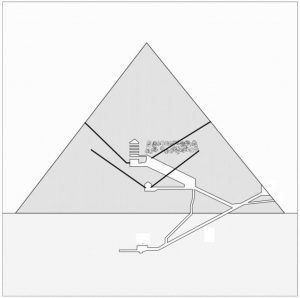
An Italian professor at the Politecnico di Milano says that there could be an iron throne right below the apex of the Pyramid of Cheops, located in the Giza pyramid complex, Egypt.
If there is such an artifact, says Professor of Archaeoastronomy Giulio Magli, it would not be melted iron but meteoritic iron, that is, fallen from the sky in the form of iron meteorites. Such mineral is distinguishable due to its high percentage of nickel. It was common for Egyptians to use it for special items designed for the Pharaohs, for example, the famous Tutankhamun dagger.
According to Magli, there’s a chance the iron throne exists because, according to ancient texts, when the pharaoh died he or she had to pass the ‘gates of the sky’ and sit on his ‘throne of iron’ before reaching the stars of the north, where he or she would dwell for eternity.

North-south section of the Great Pyramid showing (dust-filled area) the hypothetical project of the chamber, in connection with the lower southern shaft. The upper southern shaft does not intersects the chamber (as instead suggested by the section) because, when viewed in plan, it is displaced to the west with respect to the Great Gallery. Credit: Giulio Magli
Read more at: https://phys.org/news/2018-01-iron-throne-newly-chamber-cheops.html#jCp
Magli explained that within the pyramid there are four narrow shafts directed to the stars. Two of the four channels open onto the facades of the monument, while the other two run into small doors. The south door has been explored several times without results, while the north one is still sealed.
These doors, he says, are possibly representative of the “gates of the sky,” and the north one could well open into the newly discovered room. The room may contain, at its upper end and exactly under the apex of the great pyramid, an object needed by Cheops after crossing the doors—the “iron throne.”
“We can get an idea of this object’s nature by looking at the throne of Cheops’ mother, Queen Hetepheres, which has been found in pieces and reconstructed by Harvard University. It is a low chair of cedar wood covered with sheets of gold and faience. Cheops’ could be similar, but coated with thin iron sheets,” a university press release reads.
Magli made public his hypothesis this week, after careful consideration of the findings of the Scan Pyramids project, published in late 2017 by Nature. The study, conducted by scientists from the Hip Institute and the University of Nagoya, found a “huge void” at least 30 meters long within the Pyramid of Cheops. Since then, archaeologists are racing to figure out its function and content.
Comments
Restless Boomers
Lots happening in the cosmos. Interesting article, Thanks!